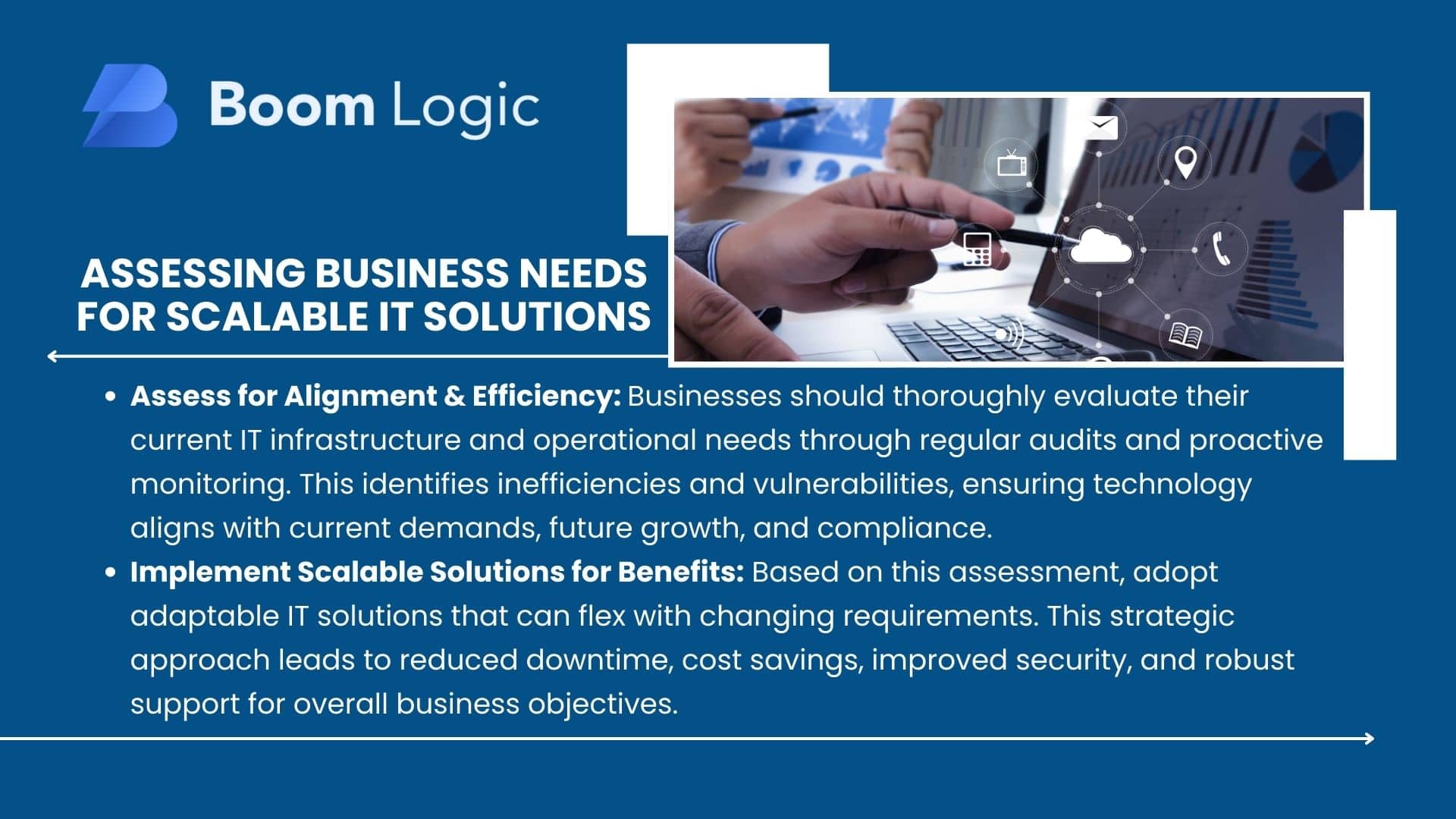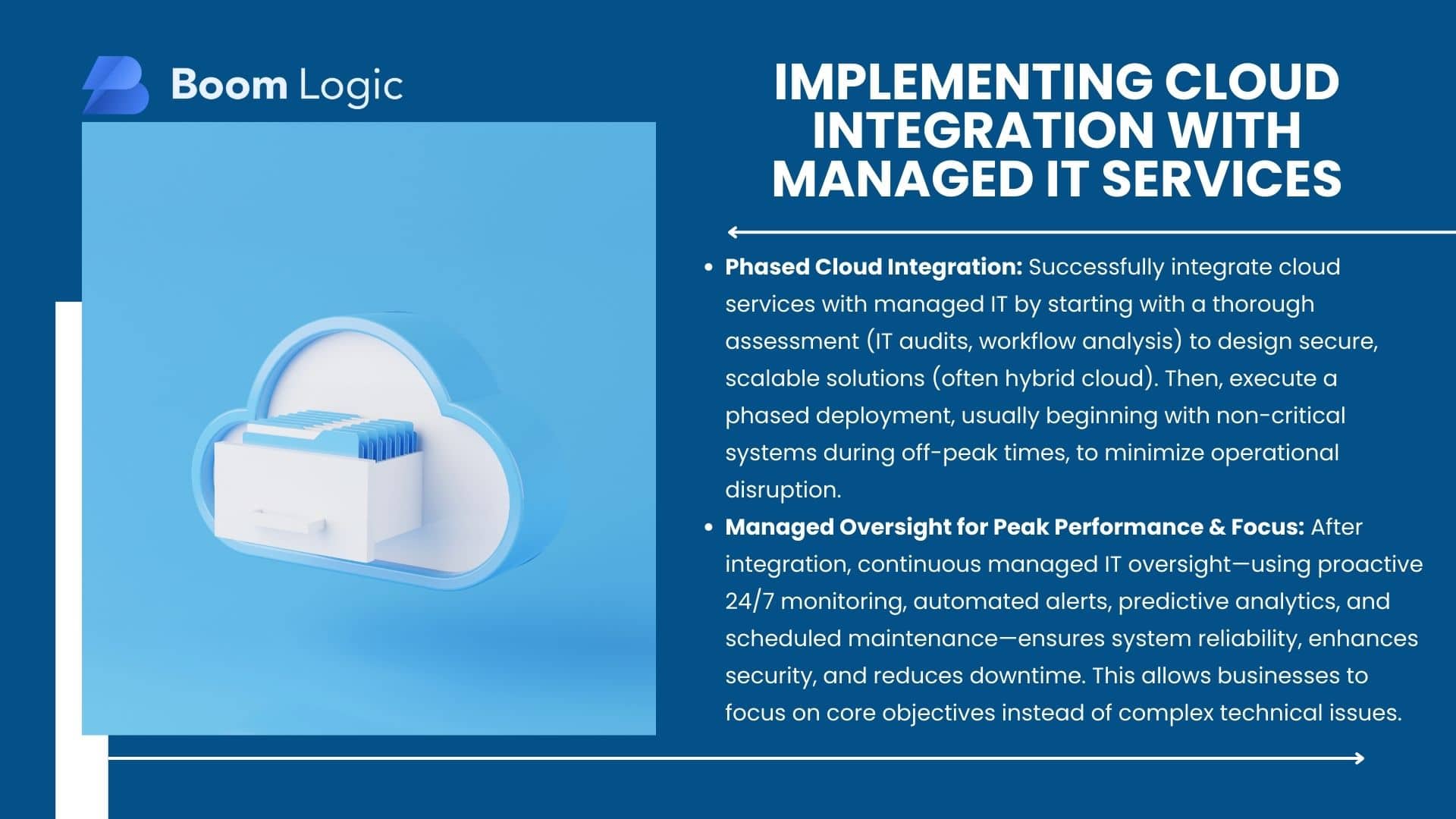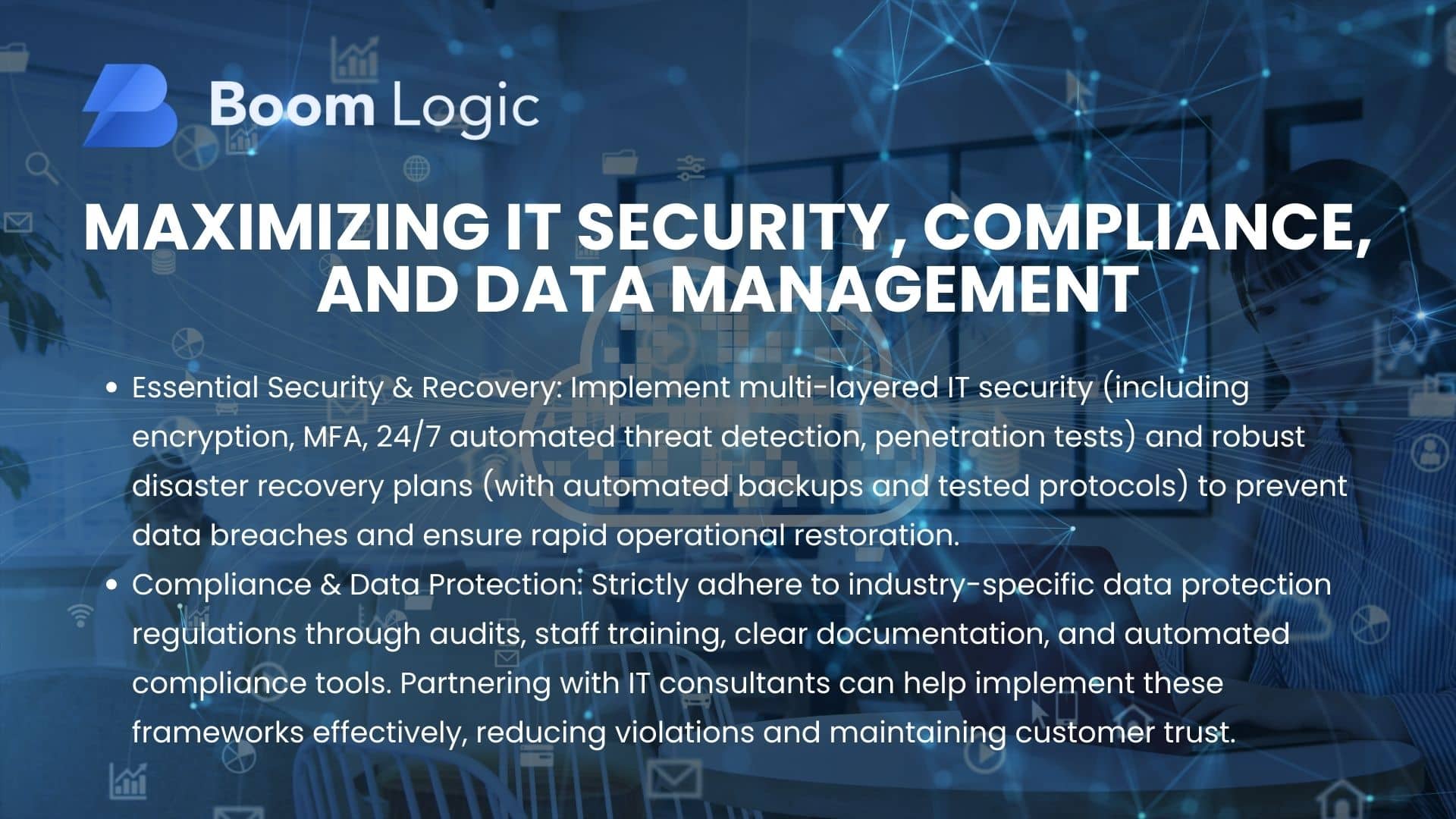Modern businesses require technology solutions that adapt to their evolving business needs. Combining scalable digital tools with expert oversight ensures smoother operations and stronger security. For companies in Southern California, Boom Logic stands out as a leader in delivering tailored IT strategies across Los Angeles, Parbadena, and Burbank.
Boom Logic’s local expertise bridges the gap between advanced cloud computing and proactive system management. Their approach minimizes downtime by anticipating issues before they disrupt workflows. This forward-thinking method not only safeguards data but also optimizes resource allocation for long-term growth.
By merging cloud flexibility with hands-on IT support, organizations gain a competitive edge. Scalable frameworks allow teams to focus on core objectives while technical demands are handled seamlessly. Transparent communication and customized solutions ensure every client’s unique requirements are met efficiently.
Key Takeaways
- Boom Logic provides specialized IT solutions across Los Angeles, Pasadena, and Burbank.
- Proactive system management reduces downtime and prevents operational disruptions.
- Integrated cloud tools enhance scalability and cybersecurity for businesses.
- Customized strategies align technology with specific organizational goals.
- Streamlined processes foster transparency and long-term operational efficiency.
Introduction to Managed IT and Cloud Services in Pasadena
Local organizations face unique challenges that demand tailored technology strategies. Specialized IT frameworks now prioritize agility and regional adaptability, ensuring operations align with market demands. For Southern California enterprises, this means balancing growth with robust infrastructure.
Boom Logic’s Regional Impact
Boom Logic has built a reputation through hands-on partnerships with LA and Burbank firms. One healthcare provider reduced system outages by 40% after adopting their monitoring tools. A Burbank marketing agency doubled project capacity through optimized data workflows.
Proximity matters in tech support. Same-day troubleshooting and personalized consultations enable faster problem resolution. This responsiveness proves critical in industries like finance, where downtime risks revenue loss.
| Factor | Local Support | Remote Providers |
|---|---|---|
| Response Time | 2-4 Hours | 24+ Hours |
| Customization | Tailored Solutions | Generic Packages |
| Cost Efficiency | Predictable Pricing | Hidden Fees |
Regional Business Dynamics
LA’s entertainment sector requires rapid data access, while Pasadena’s startups need scalable systems. Encryption protocols and multi-layered safeguards prevent breaches during expansion phases. These measures maintain client trust as companies adopt hybrid work models.
Southern California’s competitive environment rewards innovation. Strategic tech partnerships allow firms to redirect resources toward customer engagement and product development. This synergy between local expertise and advanced tools drives sustainable growth.
Understanding How Cloud Services Integrate With Managed IT Pasadena

Adaptive digital tools and expert oversight form the backbone of contemporary business success. Combining scalable platforms with specialized expertise unlocks operational agility while maintaining robust safeguards.
Core Components of Modern Systems
Scalable digital platforms allow organizations to adjust resources based on real-time demands. This flexibility reduces infrastructure costs while supporting fluctuating workloads. Proactive oversight includes network optimization, threat detection, and 24/7 system monitoring.
Driving Efficiency Through Unified Systems
Unified frameworks minimize disruptions by automating routine tasks and prioritizing critical alerts. A regional logistics company reduced downtime by 55% after consolidating its tools under one platform. Automated backups and encrypted storage further mitigate risks during unexpected events.
Tailored solutions ensure teams access vital information without delays. For example, synchronized databases enable instant updates across departments, eliminating version conflicts. These streamlined processes allow businesses to reallocate resources toward innovation rather than troubleshooting.
Assessing Business Needs for Scalable IT Solutions

Strategic technology alignment starts with understanding a company’s unique operational landscape. Organizations must evaluate existing frameworks to identify inefficiencies and future-proof their systems. This process ensures resources match both current workflows and long-term objectives.
Identifying Growth and Operational Demands
Business expansion often reveals hidden gaps in outdated infrastructure. Regular audits track software performance, hardware capacity, and security protocols. For example, a retail chain discovered 30% of its servers were underutilized during peak sales periods after a detailed assessment.
| Assessment Method | Key Benefit | Impact |
|---|---|---|
| Workflow Analysis | Identifies process bottlenecks | 23% faster task completion |
| Security Audits | Reduces breach risks | 47% fewer incidents |
| Capacity Planning | Optimizes resource use | 34% cost savings |
Evaluating Current IT Infrastructure and Gaps
Proactive monitoring tools detect vulnerabilities before they escalate. A manufacturing firm avoided $200k in downtime costs by replacing aging routers flagged during quarterly reviews. Periodic evaluations also ensure compliance with evolving industry standards.
Scalable solutions adapt to shifting demands without overburdening budgets. Automated alerts notify teams about storage limits or suspicious activity. This real-time visibility empowers companies to allocate funds strategically during upgrade cycles.
| Challenge | Pre-Assessment | Post-Assessment |
|---|---|---|
| System Downtime | 12 hours/month | 2.5 hours/month |
| Data Recovery Time | 48 hours | 6 hours |
| Compliance Gaps | 15 critical issues | 0 unresolved |
Implementing Cloud Integration with Managed IT Services

A structured approach ensures technology transitions align with organizational needs while minimizing operational friction. Strategic planning and phased execution enable businesses to adopt advanced tools without disrupting daily workflows.
Step-by-Step Guide to Migration and System Alignment
- Initial Assessment: Conduct IT audits to map existing infrastructure and identify compatibility gaps. A healthcare provider reduced migration costs by 18% through detailed workflow analysis.
- Solution Design: Prioritize data security and scalability when selecting platforms. Hybrid models often balance accessibility with compliance requirements.
- Phased Deployment: Roll out updates during low-activity periods, starting with non-critical systems. A logistics firm achieved full integration in 11 weeks using this method.
Optimizing Operations Through Continuous Oversight
Proactive monitoring detects anomalies before they escalate. Automated alerts and routine health checks maintain system reliability. One financial institution cut response times by 67% using predictive analytics.
| Monitoring Strategy | Frequency | Impact |
|---|---|---|
| Performance Scans | Hourly | 22% fewer slowdowns |
| Security Patches | Weekly | 91% breach reduction |
| Backup Tests | Monthly | 4x faster recovery |
Experienced teams streamline maintenance through scheduled updates and disaster simulations. This approach allows businesses to focus on core objectives while technical demands are handled efficiently.
Maximizing IT Security, Compliance, and Data Management

Protecting digital assets requires multi-layered defense strategies. Organizations must balance advanced safeguards with regulatory adherence to prevent breaches and operational halts. Proactive planning reduces risks while maintaining customer trust during expansion phases.
Cybersecurity Measures and Disaster Recovery Plans
Robust protocols like encryption and multi-factor authentication shield sensitive information. Automated threat detection systems scan networks 24/7, alerting teams to anomalies. Regular penetration tests identify vulnerabilities before attackers exploit them.
| Security Measure | Implementation | Impact |
|---|---|---|
| Data Encryption | Real-time file protection | 78% breach reduction |
| Backup Systems | Hourly cloud backups | 99% data recovery rate |
| Access Controls | Role-based permissions | 63% fewer internal threats |
Disaster recovery planning minimizes downtime during crises. A regional logistics firm restored operations in 90 minutes after ransomware attacks using predefined protocols. Scheduled drills ensure teams respond effectively under pressure.
Ensuring Data Protection and Regulatory Compliance
Industry-specific regulations demand tailored approaches. Healthcare providers, for example, must follow HIPAA standards for patient records. Financial institutions adhere to PCI DSS guidelines for transaction security.
Experienced consultants simplify compliance through audits and staff training. One Pasadena-based firm reduced audit failures by 82% after adopting customized frameworks. Clear documentation and automated reporting tools streamline certification processes.
- Automated compliance tracking reduces human error by 45%
- Real-time monitoring cuts incident response times by 68%
- Annual security training decreases phishing success rates by 91%
Leveraging Local Expertise in Los Angeles, Pasadena, and Burbank
Proximity drives precision in solving technology challenges. Regional teams offer faster response times and deeper insights into infrastructure needs. This localized approach transforms how businesses tackle operational hurdles and maintain competitive momentum.
Benefits of Local Support and On-Site Consulting
Nearby teams resolve critical issues within hours, not days. A Burbank law firm avoided a week-long network outage when engineers restored connectivity onsite in 90 minutes. Customized strategies address industry-specific regulations and workflow demands.
On-site consulting uncovers hidden inefficiencies. For example, a Pasadena hospital streamlined patient data access by redesigning its storage architecture during a 2-day audit. These collaborations build trust through face-to-face problem-solving.
| Advantage | Local Team | Remote Provider |
|---|---|---|
| Issue Resolution | Same-Day | 3-5 Business Days |
| System Customization | Industry-Specific | Generic Templates |
| Uptime Guarantee | 99.9% | 95% |
Real-World Success Stories from the Industry
A Los Angeles media company reduced rendering delays by 70% after upgrading its network infrastructure. Technicians identified bandwidth bottlenecks during peak production hours. This fix accelerated project delivery while cutting energy costs.
Collaborative partnerships drive lasting improvements. Key outcomes include:
- 55% faster ticket resolution for a logistics firm’s warehouse management system
- 40% fewer software conflicts after standardizing tools across a retail chain’s locations
- 98% client retention rate through proactive system upgrades and quarterly reviews
Conclusion
Adopting forward-thinking technology strategies positions businesses for sustained success. Combining scalable platforms with expert oversight minimizes downtime while strengthening security and compliance. Organizations gain agility to adapt to evolving market demands without sacrificing operational continuity.
Proactive planning ensures smooth transitions during system upgrades or data migrations. Regular monitoring and disaster recovery protocols safeguard against unexpected disruptions. These measures allow teams to focus on innovation rather than troubleshooting tech challenges.
Local expertise remains critical for addressing region-specific needs swiftly. Partners like Boom Logic deliver tailored solutions that align with Southern California’s dynamic business environment. Their rapid response times and industry-specific knowledge help companies maintain competitive momentum.
Businesses should prioritize partnerships with trusted service providers to future-proof their operations. Immediate action reduces long-term risks while unlocking cost efficiencies. Investing in integrated solutions today secures stability for years ahead.


